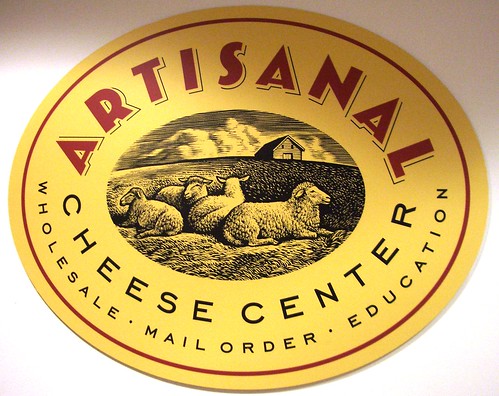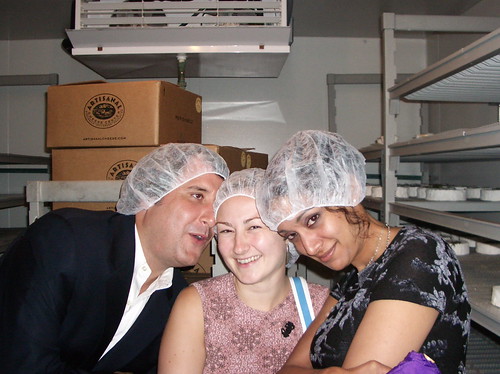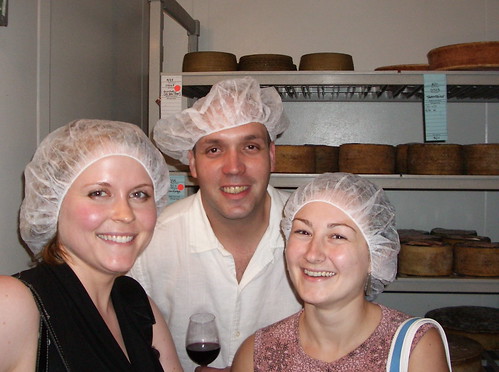It’s All About The Cheese
As anyone who knows me or has been reading this blog for a while knows, I love cheese. I love tasting new cheeses, planning a cheese “course” for a party or picking cheeses for an appetizer or dessert at a restaurant.
I took a Cheese 101 class at the Artisanal cheese center in Manhattan two years ago with my friends Erica and Sumita. After that class I bought “The Cheese Plate” by Max McCalman, who led our course. He is the rock star fromager for all of the Terrance Brennan restaurants, including Artisanal. After our class was over, Erica was able to get us an exclusive tour of the cheese “caves” where the fromagers care for and age the famous artisanal offerings.
Last week, my friend Susan joined me for a French cheese class at Artisanal lead by Fromager Daphne Zepos. We were served a selection of French cheeses and given background information about each of the cheeses as she led the tasting. Even with my knowledge of cheese, the class was enlightening and delicious.
For example, did you know that while wine was always aristocratic fare, cheese was once considered a humble food? It began as a way to preserve the milk so that farmers could survive in the lean winter months (necessity is the mother of invention after all). The aristocracy and landowners would collect the more “ephemeral” cream and butter products and leave the cheese for the farmers. I also learned that women traditionally made goat’s milk cheese. Goats were considered of “the devil” and men didn’t have the patience to deal with the temperamental beasts. It therefore became the chore of the wife to take care of the goats. The residual effects of this can be seen in the small and delicate forms many goat cheeses take. It’s a woman’s imagination that ties little packages with such care.
When looking to pair cheese with food or beverages, ideally you find pairings that elevate the taste of each. Apparently sommeliers tend to recommend cheeses that will elevate the wine and some fromagers recommend wines that elevate the cheese. There are combinations however that can elevate both. For the yogis and others that avoid alcohol, you don’t have to feel left out; here is an article on how to use juices to the same effect.
While most cheeses are gluten free, I was concerned when I discovered that one of the cheeses on our plate was dusted with breadcrumbs. (Click on the photo to go through to Flickr and see which cheese is which.) I of course avoided the breadbasket placed on each table, but was pleased to learn that fromagers consider bread merely a palate cleanser. According to Daphne, bread hinders your ability to really taste the cheese and therefore should only be eaten between each cheese. So I was perfectly happy to use water as my palate cleanser and have an expert fromager give me an additional reason for banishing bread from my cheese services.
Cheese plates are a fun way to get creative with your palate with no actual cooking time. Let me know if you find some new favorites. (and Amber, we are going to find a Sheep’s milk cheese for you!)
Tweet Pin It» Gluten-Free Restaurants NYC - Casellula Cheese and Wine Cafe | A Gluten Free Guide said,
March 22, 2009 @ 6:12 pm[…] I LOVE cheese – I love wine – I love cute little restaurants. Imagine my delight when I first heard about Casellula, a cheese and wine café in Manhattan’s Hell’s Kitchen, who’s mission is to share their “passion for hand-made cheeses with as many people as possible.” […]
Talk to Me
Is there a restaurant or bakery you want me to check-out? A product you want me to review? Any other questions or feedback?
glutenguide at gmail [dot] com
Essential Gluten-Free Guide
- Celebrate Love with a Gluten-Free Cupcake
- The Gluten-Free Diet - Sometimes it just sucks!
- Gluten-Free at Per Se - the best meal of my life
- A Gluten-Free Guide to Italy
- A Gluten-Free Guide to Paris
- He tried to make ME dinner
- Easy Gluten-Free Cheesecake
- Cookies, a gluten-free baking experiment
- Gluten-Free Thanksgiving Recipes and Tips
- Surviving the Holidays Gluten-Free
- How Food Connects All of Us
Gluten-Free Cooking Videos
- How to roast a Gluten-Free Turkey
- Gluten-Free Stuffing
- Gluten-Free Gravy
- Gluten-Free Sweet Potato Casserole
- Gluten-Free Pecan Pie
- Gluten-Free Pineapple Cheesecake
Follow me on Twitter
Become a fan on Facebook
- August 2014
- June 2012
- March 2012
- August 2011
- July 2011
- January 2011
- December 2010
- November 2010
- October 2010
- August 2010
- July 2010
- May 2010
- April 2010
- March 2010
- February 2010
- January 2010
- December 2009
- November 2009
- October 2009
- September 2009
- August 2009
- July 2009
- June 2009
- May 2009
- April 2009
- March 2009
- February 2009
- January 2009
- December 2008
- November 2008
- October 2008
- September 2008
- August 2008
- July 2008
- June 2008
- May 2008
- April 2008
- March 2008
- February 2008
- January 2008
- December 2007
- November 2007
- October 2007
- September 2007
- August 2007
- July 2007
- June 2007
- May 2007
- April 2007
- March 2007
- February 2007
- January 2007
- December 2006
- November 2006
- Book of Yum
- Delightfully Gluten-Free
- Fresh Ginger
- Gluten A Go Go
- Gluten Free South Africa
- Gluten-Free By The Bay
- Gluten-Free Food Reviews
- Gluten-Free For Good
- Gluten-Free Fun
- Gluten-Free Girl
- Gluten-Free in NYC
- Gluten-Free Journey
- Gluten-Free Living
- Gluten-Free Mommy
- Gluten-Free Steve
- Hey That Tastes Good
- I Am Gluten-Free
- Just Not Dinner
- Mike’s Gluten Free Blog
- Please Don’t Pass The Nuts
- Some Foods Are Not My Friends
- Wheatless Bay
- David Lebovitz
- Eggbeater
- La Tartine Gourmande
- Lucullian Delights
- MyRecipes
- No Recipes
- Serious Eats
- Smitten Kitchen
- The Amateur Gourmet
- Appetizers (12)
- Atlanta (11)
- Breakfast (6)
- Budget (2)
- Celiac News (7)
- Celiac Research (1)
- chicago (5)
- Chocolate (6)
- Colorado (1)
- Coping with Celiac (27)
- Cross-contamination (13)
- Denver (3)
- Desserts (32)
- Diabetes (1)
- Diagnosis (5)
- Eating Out (22)
- Entertaining (21)
- food crush (9)
- Food TV (4)
- Football (1)
- giveaways (14)
- Gluten Free Baking (26)
- Gluten Free Cooking Spree (4)
- Gluten Free Pizza Party (4)
- Grocery Stores (3)
- Holidays (20)
- Italy (12)
- Los Angeles (6)
- Lunch (1)
- Main Courses (20)
- MEME (2)
- New York (66)
- Paris February 2008 (4)
- Products (50)
- reader request (1)
- Recipes (79)
- Restaurants (87)
- Salads (4)
- Side Dishes (21)
- Travel (18)
- Tuscany 2007 (11)
- Uncategorized (20)
- vegetarian (3)
- washington dc (3)
- Yoga (2)




» Bite-Sized Gluten-Free at Krog Bar Atlanta | A Gluten Free Guide said,
March 14, 2008 @ 5:58 pm[…] left the cheese selection to me, even though I had only signed up for my French Cheese class at the time. I selected a hard sheep’s milk pecorino that reminded me of my time in Rome. The […]